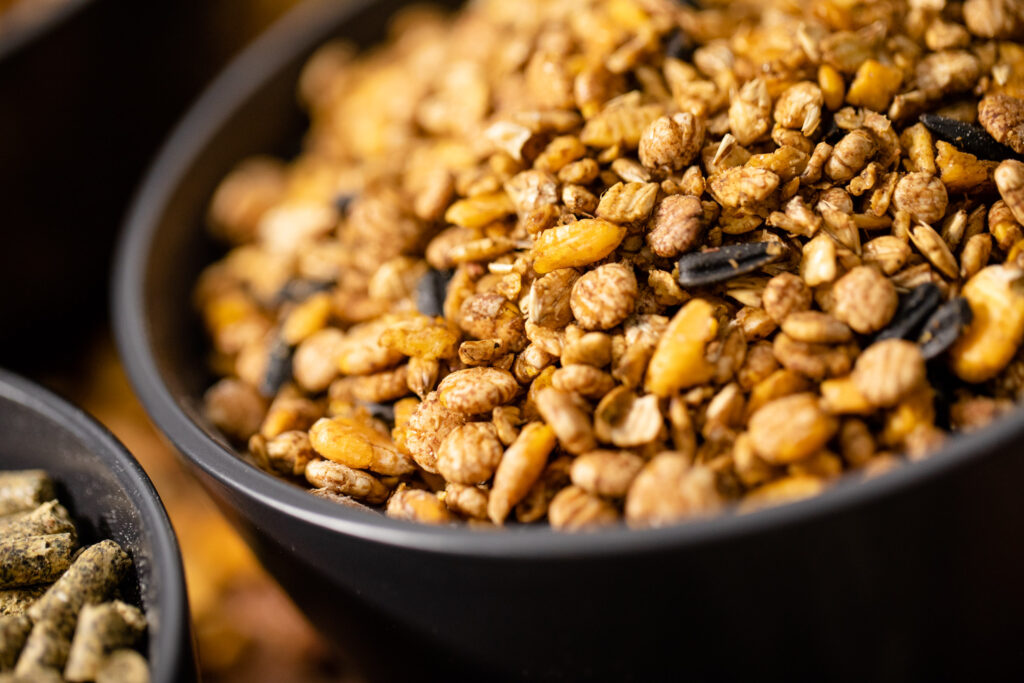
Animal feed, particularly grains, is most beneficial when it undergoes processing before being given to animals. This process enhances the nutritional value, digestibility, and overall quality of the feed, making it more suitable and beneficial for the animal’s health and well-being.
There are many types of processing:
Processing is crucial to help increase digestibility and nutrient availability. Processing also decreases anti-nutritive factors, which are substances that are unappealing to animals and make them reluctant to consume the feed.
HYGAIN has a novel processing technique, micronization, that is not seen in many of the feed mills in the United States. Micronization creates a unique product that has many benefits for your equine companion.
WHAT IS MICRONIZATION?

Mirconization is the exposure of a seed to infrared light. The energy from the light causes the water molecules in the seed to vibrate and evaporate. This increases the pressure inside the seed and cracks the seed coat, allowing animals to digest the starch inside the seed.
Micronization changes the fiber structures in seeds to provide more soluble dietary fiber, which is the fiber type that can best be utilized by the horse’s digestive tract. The process of micronization also changes the shape of the starch granules inside the seed, gelatinizing them and making them easier to absorb.
WHAT CEREAL GRAINS ARE MICRONIZED?
The following grains have been micronized for use in horse and livestock feeds:
Micronization generally improves the digestibility of these ingredients for animals when compared to other processing methods.
STARCH DIGESTION IN HORSES
The horse’s digestive tract is designed to eat large amounts of forage, which is high in fiber and low in starch. Starch, when fed, is best utilized by the horse if it is digested in the stomach and small intestine. But horses have very little amylase, which is an enzyme that breaks down starch and allows it to be used for energy. The vast majority of the horse’s amylase is found in the foregut. If we feed a diet that is too high in starch, and it overwhelms the ability of amylase to break it down, that starch will continue on to the hindgut, which can cause hindgut disturbances.
The hindgut is where the majority of the microbial digestion of fiber occurs. The microbes in the hindgut help the horse to digest and get more energy out of the fiber in their diet. When we feed high starch diets, and the starch is not digested before reaching the hindgut, the “fiber eating” microbes will die off in favor of microbes that digest starch. These “starch digesting” microbes produce lactate, which decreases the pH in the hindgut and can cause an increased susceptibility to ulcers and colic.

BENEFITS OF MICRONIZATION ON GRAINS FOR HORSES
Studies have shown that micronization enhances starch absorption by horses before the starch reaches the hindgut. In unprocessed oats, 80-90% of starch is digested in the foregut before reaching the hindgut. However, when oats undergo micronization, 97% of the starch is digested in the foregut. This increased foregut digestion yields more energy for the horse.
By limiting starch in the hindgut, natural microbial processes can focus on breaking down fiber from forage. This optimization allows horses to extract maximum nutrition from their feed sources and reduces the risk of hindgut-related digestive issues.
Subscribe to our free monthly eNewsletter and don’t miss out on the latest news in horse nutrition and management.
Subscribe to our free monthly eNewsletter and don’t miss out on the latest news in horse nutrition and management.